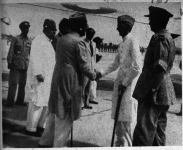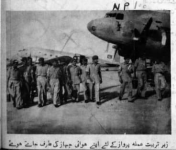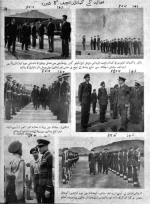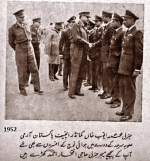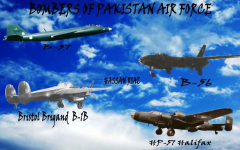ghazi52
THINK TANK: CONSULTANT
- Mar 21, 2007
- 117,031
- 167,201
- Country of Origin

- Country of Residence

- Thread starter
- #61
Contd.
At least four of the remaining ex-RIAF aircraft were returned to service during 1949, and assigned serials following the Hawker’s batch aircraft, the highest known being A156. It seems they were overhauled using newly acquired spares, and possibly cannibalised parts of written off aircraft, prior to being assigned to combat units.

Photo: A146, previously PR897, photo taken during the delivery.
The acquisition of the aircraft coincided with recruitment of the ex-Polish Air Force airmen, who remained in exile in the UK. Nearly 70 airmen and aircrew were selected, those including a fair number of fighter pilots. Due to change of RPAF policy, only a few of them made it to fighter units, the rest being dispersed between various units to fill vacancies. Most of them left Pakistan by the end of 1949.
With an improved technical and personnel situation, No. 14 Sqn was reactivated on 16 December 1949 under the command of Squadron Leader Julian Kazimierz Żuromski (835). This meant that the Fighter Bomber Wing exceeded in numbers a wartime RAF fighter Squadron! The squadron left for Miranshah on 24 March 1950 on its first operational deployment against insurgency of the Faqir of Ipi.
There is very little information available on accidents and losses of RPAF aircraft. One identified fatality was P/O Ghani Khan (865) of No. 9 Sqn, who was killed on 24 May 1950, when performing a split-S dive at high altitude his Tempest ran into high speed compressibility effects, the pilot lost control, and the aircraft broke up.
Starting from October 1949 Pakistan took delivery of the first batch of 50 Sea Fury fighters, which ultimately replaced Tempests in combat units. The first Squadron, No. 9, converted onto the new aircraft in July 1950, but due to a shortage of Sea Furies, it flew Tempests once again from November 1950 until February 1951. About the time, all fighter bomber squadrons phased out their Tempests.
The final batch of 21 Tempests was acquired from RAF stocks in Malaya starting in November 1951 and ending in November 1952. Following a long period in storage the aircraft were in bad condition and at least three were lost during the delivery flights. This deal was widely disputed in Pakistan, as those aircraft were deemed unnecessary. The highest known serial is A165.
Tempests, deemed as a reserve, were stored at Equipment Depot, RPAF Chaklala, and some of them continued service for a while in the Conversion Squadron at Risalpur, and were then relegated to second line duties like target towing or as instructional airframes. In September 1953 No. 12 Heavy Bomber Squadron was converted into Composite Squadron. In the new establishment, the Squadron had three flights: Air Headquarters Communication Flight operating Dakotas and a single Viking, Target Towing Flight with Tempests, and Heavy Bomber Flight flying Halifaxes. The last target towing Tempests were seen in Pakistan in 1958. None survives to the present day.
Tempests, the first combat aircraft of Pakistan, were remembered as good aircraft, but tricky to fly due to tendency to swing on landing. Some pilots complained about condition of the aircraft and crude finish of wartime production standards. Centaurus engines turned out to be temperamental, and caused a lot of problems, partly due to a lack of spares and proper servicing. The replacement Sea Fury was found to be a superior aircraft in all respects. The last surviving Sea Furies remained in combat use until 1964.
Colours & markings
It is likely that the original 35 aircraft inherited from RAF stocks were painted in RAF colours. At the time the RAF used two schemes: the Day Fighter Scheme, with Dark Green and Ocean Grey disruptive pattern with Medium Sea Grey undersurfaces, and the Silver scheme with all surfaces painted silver. However there is no evidence of the use of the Silver scheme on Pakistani Tempests.

The 24 aircraft that were delivered from Hawker were painted in Desert Scheme of Dark Earth and Middle Stone disruptive pattern with Azure Blue undersurfaces, and Azure Blue spinner. Due to infrequent painting, repairs, and wear, aircraft started to look rather worn toward the end of their service. It seems after 1950 following the withdrawal of Tempests from operational units, the aircraft were gradually repainted in silver. Target tug aircraft had undersurfaces painted in a single colour, possibly yellow.
National markings consisted of the Pakistani roundel, white and green with yellow outline on wings and fuselage, and on the tail a green square with yellow outline and a white crescent with star, on both sides of the aircraft; the crescent faced to the rear on both sides. Serials were painted in black on fuselage sides and on wing undersurfaces in typical RAF pattern of the time. They were introduced on 6th December 1947.
At the same time quick identification markings were applied in the form of double white stripe around the rear fuselage, each band formed into a chevron on the fuselage sides (pointing forwards), and also double white chevrons at both wing roots and pointing towards the fuselage. There is a photo of a Tempest showing single black stripe at both wing roots, but it is uncertain if it is variation of the above marking or unrelated. Starting from 1949 those markings were gradually removed.
Spinners were painted in squadron colours, No 5 Sqn dark blue, No 9 Sqn red, No 14 Sqn white, left in factory colour or repainted, possibly with one of camouflage colours. No squadron emblems, popular on Sea Furies, were noticed on Tempests. There is a single photo of a Tempest showing an emblem on the cowling, which cannot be tied with any unit, possibly a personal marking.
Squadrons used code letters in white in front (to nose) of the fuselage roundels and in black on front bottom cowling. Later, in 1949, with the removal of identification stripes from the tail, code letters moved after the roundel (gradually on old aircraft, and immediately on newly delivered ones). It seems that white section on bottom of the front cowling was added as a background to the code at the same time, but no clear rule could be deduced. Only some aircraft received codes, probably those assigned to particular pilots, even if flown on availability basis. Favourite letters were used, eg. M for S/L ‘Bertie’ Mirza.
At least four of the remaining ex-RIAF aircraft were returned to service during 1949, and assigned serials following the Hawker’s batch aircraft, the highest known being A156. It seems they were overhauled using newly acquired spares, and possibly cannibalised parts of written off aircraft, prior to being assigned to combat units.
Photo: A146, previously PR897, photo taken during the delivery.
The acquisition of the aircraft coincided with recruitment of the ex-Polish Air Force airmen, who remained in exile in the UK. Nearly 70 airmen and aircrew were selected, those including a fair number of fighter pilots. Due to change of RPAF policy, only a few of them made it to fighter units, the rest being dispersed between various units to fill vacancies. Most of them left Pakistan by the end of 1949.
With an improved technical and personnel situation, No. 14 Sqn was reactivated on 16 December 1949 under the command of Squadron Leader Julian Kazimierz Żuromski (835). This meant that the Fighter Bomber Wing exceeded in numbers a wartime RAF fighter Squadron! The squadron left for Miranshah on 24 March 1950 on its first operational deployment against insurgency of the Faqir of Ipi.
There is very little information available on accidents and losses of RPAF aircraft. One identified fatality was P/O Ghani Khan (865) of No. 9 Sqn, who was killed on 24 May 1950, when performing a split-S dive at high altitude his Tempest ran into high speed compressibility effects, the pilot lost control, and the aircraft broke up.
Starting from October 1949 Pakistan took delivery of the first batch of 50 Sea Fury fighters, which ultimately replaced Tempests in combat units. The first Squadron, No. 9, converted onto the new aircraft in July 1950, but due to a shortage of Sea Furies, it flew Tempests once again from November 1950 until February 1951. About the time, all fighter bomber squadrons phased out their Tempests.
The final batch of 21 Tempests was acquired from RAF stocks in Malaya starting in November 1951 and ending in November 1952. Following a long period in storage the aircraft were in bad condition and at least three were lost during the delivery flights. This deal was widely disputed in Pakistan, as those aircraft were deemed unnecessary. The highest known serial is A165.
Tempests, deemed as a reserve, were stored at Equipment Depot, RPAF Chaklala, and some of them continued service for a while in the Conversion Squadron at Risalpur, and were then relegated to second line duties like target towing or as instructional airframes. In September 1953 No. 12 Heavy Bomber Squadron was converted into Composite Squadron. In the new establishment, the Squadron had three flights: Air Headquarters Communication Flight operating Dakotas and a single Viking, Target Towing Flight with Tempests, and Heavy Bomber Flight flying Halifaxes. The last target towing Tempests were seen in Pakistan in 1958. None survives to the present day.
Tempests, the first combat aircraft of Pakistan, were remembered as good aircraft, but tricky to fly due to tendency to swing on landing. Some pilots complained about condition of the aircraft and crude finish of wartime production standards. Centaurus engines turned out to be temperamental, and caused a lot of problems, partly due to a lack of spares and proper servicing. The replacement Sea Fury was found to be a superior aircraft in all respects. The last surviving Sea Furies remained in combat use until 1964.
Colours & markings
It is likely that the original 35 aircraft inherited from RAF stocks were painted in RAF colours. At the time the RAF used two schemes: the Day Fighter Scheme, with Dark Green and Ocean Grey disruptive pattern with Medium Sea Grey undersurfaces, and the Silver scheme with all surfaces painted silver. However there is no evidence of the use of the Silver scheme on Pakistani Tempests.

The 24 aircraft that were delivered from Hawker were painted in Desert Scheme of Dark Earth and Middle Stone disruptive pattern with Azure Blue undersurfaces, and Azure Blue spinner. Due to infrequent painting, repairs, and wear, aircraft started to look rather worn toward the end of their service. It seems after 1950 following the withdrawal of Tempests from operational units, the aircraft were gradually repainted in silver. Target tug aircraft had undersurfaces painted in a single colour, possibly yellow.
National markings consisted of the Pakistani roundel, white and green with yellow outline on wings and fuselage, and on the tail a green square with yellow outline and a white crescent with star, on both sides of the aircraft; the crescent faced to the rear on both sides. Serials were painted in black on fuselage sides and on wing undersurfaces in typical RAF pattern of the time. They were introduced on 6th December 1947.
At the same time quick identification markings were applied in the form of double white stripe around the rear fuselage, each band formed into a chevron on the fuselage sides (pointing forwards), and also double white chevrons at both wing roots and pointing towards the fuselage. There is a photo of a Tempest showing single black stripe at both wing roots, but it is uncertain if it is variation of the above marking or unrelated. Starting from 1949 those markings were gradually removed.
Spinners were painted in squadron colours, No 5 Sqn dark blue, No 9 Sqn red, No 14 Sqn white, left in factory colour or repainted, possibly with one of camouflage colours. No squadron emblems, popular on Sea Furies, were noticed on Tempests. There is a single photo of a Tempest showing an emblem on the cowling, which cannot be tied with any unit, possibly a personal marking.
Squadrons used code letters in white in front (to nose) of the fuselage roundels and in black on front bottom cowling. Later, in 1949, with the removal of identification stripes from the tail, code letters moved after the roundel (gradually on old aircraft, and immediately on newly delivered ones). It seems that white section on bottom of the front cowling was added as a background to the code at the same time, but no clear rule could be deduced. Only some aircraft received codes, probably those assigned to particular pilots, even if flown on availability basis. Favourite letters were used, eg. M for S/L ‘Bertie’ Mirza.

